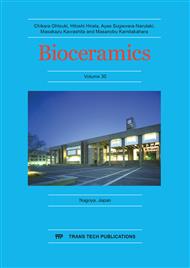[1]
F. Grinnell, M. K. Feld, Adsorption characteristics of plasma fibronectin in relationship to biological activity, J. Biomed. Mater. Res. 15 (1981) 363-381.
DOI: 10.1002/jbm.820150308
Google Scholar
[2]
D.L. Coleman, D.E. Gregonis, J.D. Andrade, Blood-materials interactions: the minimum interfacial free energy and the optimum polar/apolar ratio hypotheses, J. Biomed. Mater. Res. 16 (1982) 381-398.
DOI: 10.1002/jbm.820160407
Google Scholar
[3]
A.S. Hoffman, Letter to the editor: A general classification scheme for hydrophilic and hydrophobic biomaterial surfaces, J. Biomed. Mater. Res. 20 (1986) ix-xi.
DOI: 10.1002/jbm.820200903
Google Scholar
[4]
J. M. Schakenraad, J. Arends, H. J. Busscher, F. Dijk, P. B. van Wachem, C. R. H. Wildevuur, Kinetics of cell spreading on protein precoated substrate: a study of interfacial aspects, Biomaterials, 10 (1989) 43-50.
DOI: 10.1016/0142-9612(89)90008-2
Google Scholar
[5]
S. D. Johnson, J. M. Anderson, R. E. Marchant, Biocompatibility studies on plasm polymerized interface materials encompassing both hydrophobic and hydrophilic surfaces, J. Biomed. Mater. Res. 26 (1992) 915-935.
DOI: 10.1002/jbm.820260707
Google Scholar
[6]
J. F. Schultz and D. R. Armant, Beta 1- and beta 3-class integrins mediate fibronectin binding activity at the surface of developing mouse peri-implantation blastocysts. Regulation by ligand-induced mobilization of stored receptor, J. Biol. Chem. 270 (1995).
DOI: 10.1074/jbc.270.19.11522
Google Scholar
[7]
H. M. Kim, F. Miyaji, T. Kokubo, T. Nakamura, Preparation of bioactive Ti and its alloys via simple chemical surface treatment, J. Biomed. Mater. Res. 32 (1996) 409-417.
DOI: 10.1002/(sici)1097-4636(199611)32:3<409::aid-jbm14>3.0.co;2-b
Google Scholar
[8]
M. Uchida, H. M. Kim, T. Kokubo, S. Fujibayashi, T. Nakamura, Effect of water treatment on the apatite-forming ability of NaOH-treated titanium metal, J. Biomed. Mater. Res. (Appl. Biomater.) 63 (2002) 522-530.
DOI: 10.1002/jbm.10304
Google Scholar
[9]
T. Kokubo, D. K. Pattanayak, S. Yamaguchi, H. Takadama, T. Matsushita, T. Kawai, M. Takemoto, S. Fujibayashi, T. Nakamura, Positively charged bioactive Ti metal prepared by simple chemical and heat treatments, J. R. Soc. Interface 7 (2010).
DOI: 10.1098/rsif.2010.0129.focus
Google Scholar
[10]
S. Yamaguchi, H. Takadama, T. Matsushita, T. Nakamura, T. Kokubo, Preparation of bioactive Ti-15Zr-4Nb-4Ta alloy from HCl and heat treatments after an NaOH treatment, J. Biomed. Mater. Res. A 97A (2011) 135-144.
DOI: 10.1002/jbm.a.33036
Google Scholar
[11]
C. Ohtsuki, H. Iida, S. Hayakawa, A. Osaka, Bioactivity of titanium treated with hydrogen peroxide solutions containing metal chlorides, J. Biomed. Mater. Res. 35 (1997) 39-47.
DOI: 10.1002/(sici)1097-4636(199704)35:1<39::aid-jbm5>3.0.co;2-n
Google Scholar
[12]
X. X. Wang, S. Hayakawa, K. Tsuru, A. Osaka, A comparative study of in vitro apatite deposition on heat-, H2O2-, and NaOH-treated titanium surfaces, J. Biomed. Mater. Res. 54 (2001) 172-178.
DOI: 10.1002/1097-4636(200102)54:2<172::aid-jbm3>3.0.co;2-#
Google Scholar
[13]
X. X. Wang, W. Yan, S. Hayakawa, K. Tsuru, A. Osaka, Apatite deposition on thermally and anodically oxidized titanium surfaces in a simulated body fluid, Biomaterials 24 (2003) 4631-4637.
DOI: 10.1016/s0142-9612(03)00357-0
Google Scholar
[14]
A. Sugino, K. Uetsuki, K. Tsuru, S. Hayakawa, C. Ohtsuki, A. Osaka, Gap effect on the heterogeneous nucleation of apatite on thermally oxidized titanium substrate, Key Eng. Mater. 361-363 (2008) 621-624.
DOI: 10.4028/www.scientific.net/kem.361-363.621
Google Scholar
[15]
A. Sugino, K. Uetsuki, K. Tsuru, S. Hayakawa, A. Osaka, C. Ohtsuki, Surface topography designed to provide osteoconductivity to titanium after thermal oxidation, Mater. Trans. 49 (2008) 428-434.
DOI: 10.2320/matertrans.mbw200711
Google Scholar
[16]
T. Shozui, K. Tsuru, S. Hayakawa, A. Osaka, Enhancement of in vitro apatite-forming ability of thermally oxidized titanium surfaces by ultraviolet irradiation, J. Ceram. Soc. Jpn. 116 (2008) 530-535.
DOI: 10.2109/jcersj2.116.530
Google Scholar
[17]
M. Hashimoto, K. Kashiwagi, S. Kitaoka, A nitrogen doped TiO2 layer on Ti metal for the enhanced formation of apatite, J. Mater. Sci. Mater. Med. 22 (2011) 2013-(2018).
DOI: 10.1007/s10856-011-4389-1
Google Scholar
[18]
M. Hashimoto, K. Hayashi, S. Kitaoka, Enhanced apatite formation on Ti metal heated in PO2-controlled nitrogen atmosphere, Mat. Sci. Eng. C 33 (2013) 4155-4159.
DOI: 10.1016/j.msec.2013.06.003
Google Scholar
[19]
M. Hashimoto, S. Kitaoka, S. Muto, K. Tatsumi, Y. Obata, The microstructure of scale formed by oxynitriding of Ti and exhibiting significant apatite-forming ability, J. Mater. Res. 31(8) (2016) 1004-1011.
DOI: 10.1557/jmr.2016.79
Google Scholar
[20]
M. Hashimoto, S. Kitaoka, Y. Obata, S. Muto, T. Ogawa, M. Furuya, H. Kanetaka, Control of HAp formation and osteoconductivity on nitrogen-doped TiO2 scale formed by oxynitridation of Ti, Key Eng. Mat. 758 (2017) 86-89.
DOI: 10.4028/www.scientific.net/kem.758.86
Google Scholar
[21]
M. Hashimoto, T. Ogawa, S. Kitaoka, S. Muto, M. Furuya, H. Kanetaka, M. Abe, H. Yamashita, Control of surface potential and hydroxyapatite formation on TiO2 scales containing nitrogen-related defects, Acta Materialia, 155 (2018) 379-385.
DOI: 10.1016/j.actamat.2018.05.072
Google Scholar
[22]
M. Kawashita, J. Hayashi, T. Kudo, H. Kanetaka, Z. Li, T. Miyazaki, MC3T3-E1 and RAW264.7 cell response to hydroxyapatite and alpha-type alumina adsorbed with bovine serum albumin, J. Biomed. Mater. Res. Part A 102A (2014) 1880-1886.
DOI: 10.1002/jbm.a.34861
Google Scholar
[23]
M. Hasegawa, T. Kudo, H. Kanetaka, T. Miyazaki, M. Hashimoto, M. Kawashita, Fibronectin adsorption on osteoconductive hydroxyapatite and non-osteoconductive a-alumina, Biomed. Mater. 11 (2016) 045006.
DOI: 10.1088/1748-6041/11/4/045006
Google Scholar


